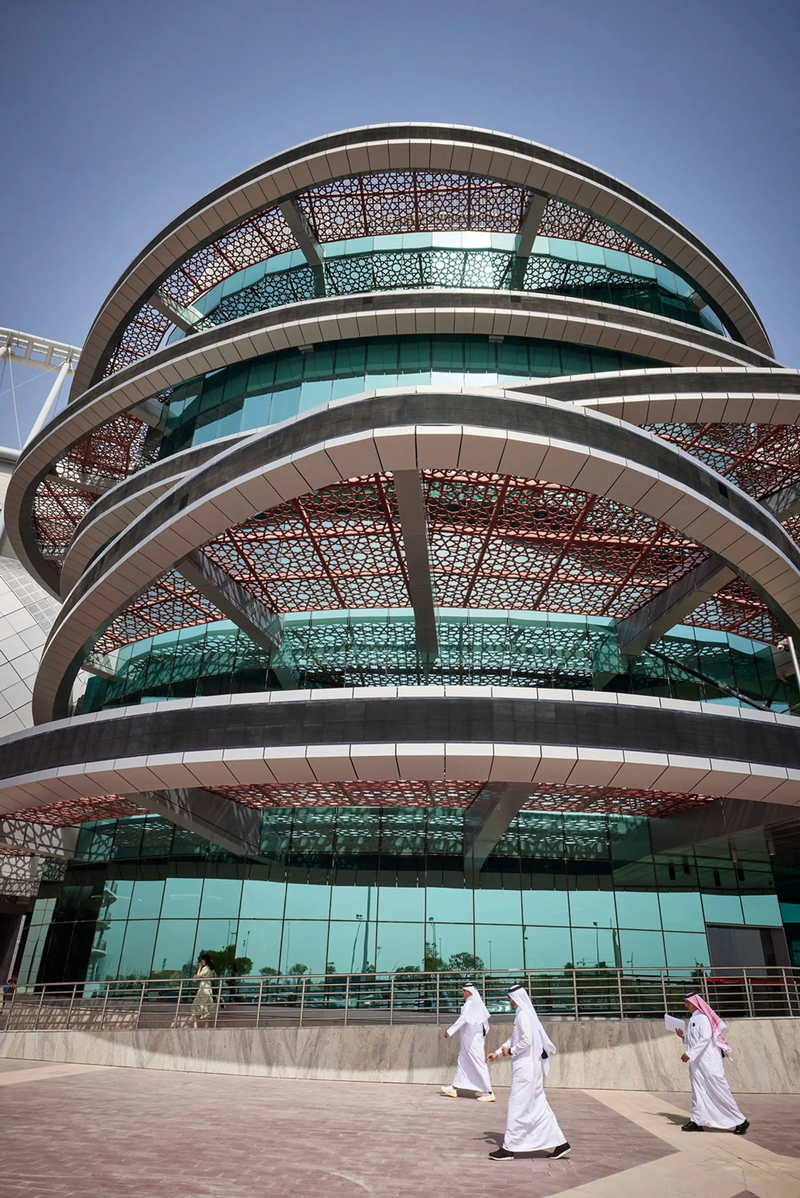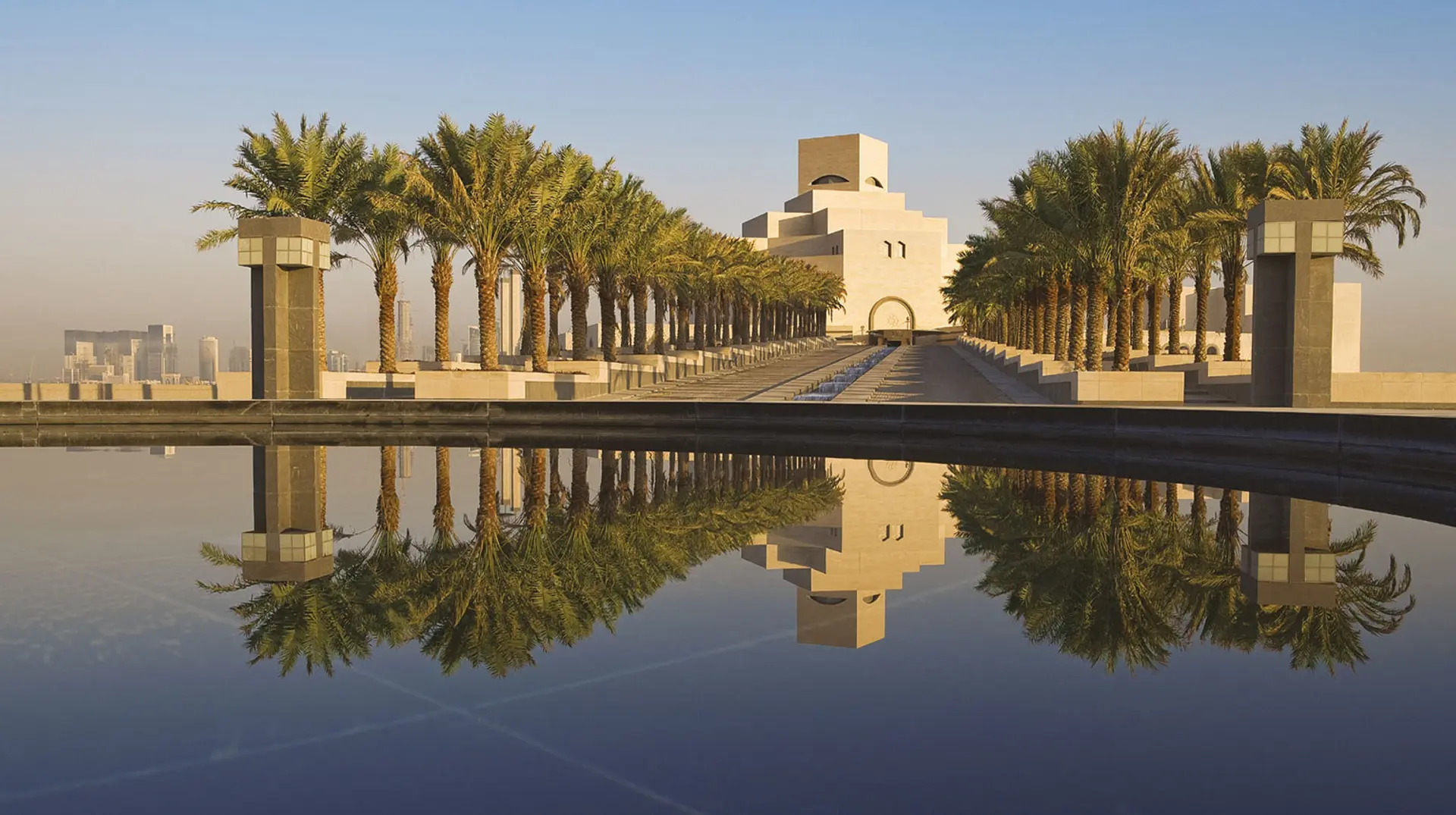Forget the World Cup: Qatar kicks off a major museum-building programme

Written by Hannah McGivern. Originally published by The Art Newspaper, 30 November 2022.
While Qatar raced to complete its new football stadia, metro stations and hotels in time to host the 1.5 million tourists arriving for the Fifa World Cup 2022, its ambitious cultural developments were believed to have taken a back seat. But, in the run-up to the tournament, the country’s authority for cultural institutions and heritage sites has announced a wave of future construction projects—and revealed the first details of the museums that will house the country’s extensive art collections.
In 2006, Sheikha Al Mayassa bint Hamad bin Khalifa Al Thani emerged as one of the art world’s power collectors after her father, the then ruling emir, appointed her to run Qatar Museums (QM). A report by The New York Times in 2013 estimated her annual acquisitions budget was $1bn. A string of record-breaking purchases on the global art market, including works by Paul Cézanne, Mark Rothko and Damien Hirst, fuelled speculation that Doha was preparing a museum of international Modern and contemporary art to add to the Museum of Islamic Art, which reopened in October after an 18-month overhaul, and Mathaf: Arab Museum of Modern Art.
Rich in oil and natural gas, the Gulf state sharply curbed public spending in 2016 in the wake of crashing oil prices. Though QM does not disclose budget information, sources close to the organisation told The Art Newspaper at the time that cutbacks had placed projects for the children’s and Orientalist museums on hold for “the foreseeable future” and that “everything else is taking second place to [the World Cup]”. The long-awaited National Museum of Qatar, housed in Jean Nouvel’s desert rose-inspired building, opened in Doha several years behind schedule in March 2019. The 3-2-1 Qatar Olympic and Sports Museum, once planned to open in 2015, was inaugurated earlier this year at the Khalifa national stadium.
Now, with those major legacy projects completed, QM has relaunched plans for four more museums in the coming decade. The Qatar Auto Museum, designed by Rem Koolhaas’s firm OMA, is scheduled for 2024, and Dadu, Children’s Museum of Qatar, for 2026. The ultimate goal, according to Sheikha Al Mayassa, is to support the Qatar National Vision 2030; to diversify the economy away from fossil fuels, raise living standards and bolster its international influence.
By that date, the country will have two major new galleries embracing a global narrative. Breaking ground next year for a 2029 opening, the Lusail Museum is being designed by Swiss architects Herzog & de Meuron in the new entertainment district north of Doha. The Art Mill Museum is moving forward five years after Alejandro Aravena’s firm Elemental won the project to repurpose a vast flour mill by Doha Bay; its target opening is 2030 (see p29). Preview exhibitions are now raising the curtain on the design and curatorial vision of both museums as part of QM’s biggest ever culture programme, which kicked off shortly before the World Cup.
“Globalisation didn’t wait for the 21st century to happen,” said Xavier Dectot, the Lusail Museum’s French director, during a press tour of Tales of a Connected World, a show exploring the history of cultural encounters around the Indian Ocean. At its core is the collection of 19th-century
Orientalist art amassed by the former emir. Relying on Western imperialist stereotypes of an exotic East, Orientalism may seem a disconcerting starting point for a museum in the Gulf. But the displays set out to dissect the myths, placing them alongside “local visions of people talking about their own territory”, Dectot says.
After Qatar finished the National Museum, “it was time” to reposition the Orientalist collection, says the project lead Karen Exell, a British academic. The Lusail Museum is augmenting the art with film, music, fashion and other representations of cultural exchange. “It’s about positioning Qatar within [the Indian Ocean] and looking out into the world,” Exell says. In a new book published to coincide with the World Cup, The Power of Culture, Sheikha Al Mayassa writes that the museum “will seek to spark
conversations about decolonisation, multiple
representation, tolerance and peace”.
Dedicated to Modern and contemporary art from the mid-1800s to the present, the Art Mill Museum also bears the imprint of the Sheikha’s motto: “Globalising the local, localising the global”. She is the museum’s president and has assembled a scientific committee including Gus Casely-Hayford, the director of the forthcoming V&A East in London, and Adam Weinberg, the director of the Whitney Museum of American Art in New York. Catherine Grenier, the director of the Fondation Giacometti in Paris and former deputy chief of the Centre Pompidou, is leading the curatorial strategy.
Equal level
While Western museums grapple with calls to diversify and decolonise, Grenier tells The Art Newspaper that the Art Mill is an opportunity to create “a global art museum” representing artists from all regions, including the Gulf, “on an equal level”. Works will be drawn from across QM’s collections, she says, so the multidisciplinary displays will also feature literature, films and cinema props, photography, folk art, architecture and design—even cars. “It’s as if it were several different museums under one single roof, with no division between the sections.”
Alluding to Qatar’s 85% foreign population, Grenier says: “We want to be the museum for this cosmopolitan society.” But how will it cater to the country’s traditionally conservative Islamic values? QM removed an Adel Abdessemed public sculpture in 2013 after some Qatari social-media users decried the depiction of Zinedine Zidane’s 2006 World Cup head-butt as idolatrous. “We want to show works that the public will accept, of course,” Grenier says. “So we don’t have the Western standards, we have the global standards.” The museum will stage pre-opening outreach events with contemporary artists to prepare local audiences, she adds.
Serena Iervolino, a former lecturer in museology and curatorial studies at UCL Qatar, says controversial artworks probably “won’t make it to the gallery space” at the Art Mill because “artists and curators who agree to work for or with QM have a clear understanding of the limits imposed by local conservative cultural sensitivities”.
Massimiliano Gioni, who has guest-curated exhibitions of Takashi Murakami and Jeff Koons in Doha, says he was asked to avoid works featuring nudity or subjects deemed sensitive, such as the depiction of religious figures. But he emphasises the “importance of participation and dialogue” with Qatar’s growing cultural community and the positive impact for
creatives in the region, citing Sheikha Al Mayassa’s work with the Fashion Trust Arabia to support emerging Arab fashion designers. “I think these events can transform and contribute greatly to the acceptance of difference and complexity,” he says.

Under the spotlight of the World Cup, Qatar has been widely criticised for its restrictions on freedom of expression, laws against same-sex relationships and treatment of the migrant construction workers who built the stadia. In late October, the British activist Peter Tatchell was briefly detained after staging a one-man protest outside the National Museum in Doha, which he said was the first public LGBT protest in the Gulf. Amid calls to boycott the World Cup, numerous professional footballers have spoken out over human rights issues in the country.
Qatari officials have pushed back at the criticism, pointing to recent labour reforms. The emir has said that visitors of all backgrounds will be welcome at the World Cup, but asked that they “respect our culture”. In a statement provided to The Art Newspaper, QM says that “all are welcome” in its spaces and that it “welcomes artists from all backgrounds,
ethnicities, religions and languages”. Asked how it will
safeguard the labourers building its museums and public art installations, QM says the state public works authority Ashghal is responsible for ensuring “appropriate labour conditions” on its projects and that it “carries out regular safety checks and inspections”. Construction contracts “fall within government guidelines including provision for issues around safe summer working hours, the wage protection system and more general issues such as the provision of accommodation”, it says. “We are committed to the health and welfare of workers in Qatar and continue to look for areas where we can improve.”